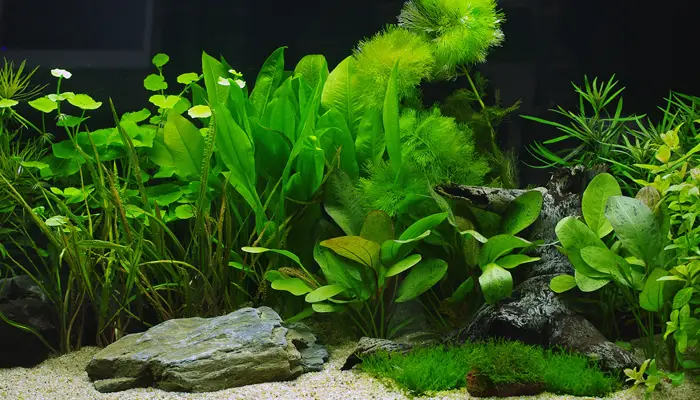Learn how aquarium lighting (spectrum, PAR, photoperiod) affects plants, corals and fish. Practical recommendations for planted tanks, reefs and displays in Delhi NCR.
Introduction — why lighting matters
Lighting is far more than “how bright it looks.” For aquariums, light drives photosynthesis in plants and corals, influences fish behaviour and colour, affects algae dynamics, and interacts with tank depth, water clarity and livestock needs. Choosing the wrong light — wrong spectrum, insufficient PAR, or incorrect photoperiod — causes poor plant growth, coral bleaching, algae blooms, and wasted electricity.
This guide explains the science (spectrum, PAR, kelvins etc.), how to measure and choose lighting for different aquarium types, practical installation and tuning advice, troubleshooting, and local considerations for Delhi NCR homes and offices.
1. Key concepts — what you must understand
Spectrum (wavelength):
- Definition: Light is made of wavelengths; together they form a spectrum.
- Why it matters: Different organisms use different wavelengths. Plants and corals use primarily blue and red spectra for photosynthesis, but a balanced full-spectrum light (including green) produces natural colour rendering and healthy growth.
- Practical: “Full-spectrum” LEDs emulate daylight (broad wavelengths), but check the spectral power distribution (SPD) if possible — look for peaks in ~450 nm (blue) and 620–680 nm (red) for plants; reefs favour strong blue (400–490 nm) for coral fluorescence and photosynthesis.
PAR — Photosynthetically Active Radiation:
- Definition: PAR measures the quantity of light (µmol·m⁻²·s⁻¹) usable by plants and photosynthetic corals — the photons in 400–700 nm range per square meter per second.
- Why PAR > lumens: Lumens measure human-perceived brightness; PAR measures biologically useful photons. For aquaria, PAR is the correct metric for plant and coral growth.
- Practical ranges (general) –
- Low-light planted tanks: 20–50 µmol·m⁻²·s⁻¹ at substrate/plant canopy
- Medium-light planted tanks: 50–100 µmol·m⁻²·s⁻¹
- High-tech planted (carpets, demanding red plants): 100–300 µmol·m⁻²·s⁻¹ (near substrate)
- Soft corals / LPS corals: 50–150 µmol·m⁻²·s⁻¹ (depth-dependent)
- SPS corals: 200–450 µmol·m⁻²·s⁻¹ (high PAR, strong blue spectrum)
Note: target PAR must be measured at the plant/coral level — not at the fixture.
Photoperiod (day length):
- Definition: Hours of light per day.
- Typical ranges:
- Planted tanks (low→high tech): 6–8 hours (low) up to 8–10 hours (high-tech with CO₂)
- Reef tanks: 8–10 hours with blue actinic ramping before/after main lights
- Avoid >10–11 hours unless you have superb nutrient control (long photoperiod → algae)
Color Temperature (Kelvin):
- Definition: Perceived “warmth” or “coolness” of light.
- Common choices:
- Planted freshwater: 6500K–8000K (natural daylight look)
- Marine/reef: often blended with higher blue content — 10,000K–20,000K (appearance only; biology is about PAR & spectrum)
- Practical: Kelvin affects appearance; do not confuse Kelvin with PAR or spectral peaks.
2. Choosing the right light for your tank type
Planted Freshwater (low-tech → high-tech):
- Low-tech (no CO₂, easy plants): moderate PAR (20–70 µmol·m⁻²·s⁻¹), full-spectrum LED 6–8 hr, stable dosing, and avoid intense red-heavy fixtures that promote algae if nutrients are imbalanced.
- Medium-tech (OC-driven, rudimentary CO₂): PAR 50–120 µmol·m⁻²·s⁻¹; 7–8 hr photoperiod with ramping; use full-spectrum + dedicated plant diodes; pair with EI or consistent dosing.
- High-tech (carpet plants, red species): PAR 100–300 µmol·m⁻²·s⁻¹; CO₂ injection mandatory with stable dosing regime (EI or precision ppm); 8–9 hr photoperiod and careful nutrient control to avoid algae.
Marine & Reef Tanks:
- Soft corals / LPS: PAR 50–150; balanced full-spectrum with strong blue channel for fluorescence; photoperiod ~8–10 hr with actinic ramping.
- SPS-dominant reef: High PAR (200–450), intense blue peaks (420–460 nm). Use high-quality reef fixtures with good cooling, multiple channels, and programmable cycles. Maintain stable chemistry (alkalinity, calcium, magnesium).
Brackish & Biotope Tanks:
- General: Use lighting that matches the natural habitat — mangroves and estuaries often have lower light; brackish archerfish setups need moderate light. Biotope aquaria aiming for authenticity may use lower PAR and natural-looking Kelvin.
Display & Aesthetic Tanks (non-planted):
- Goal: Good colour rendering (CRI), visual appeal. Full-spectrum 4000–6500K with moderate PAR; photoperiod 6–8 hr.
3. Fixture types & technology
LED fixtures (recommended):
- Efficient, tunable, long life, low heat when cooled properly. Choose fixtures with:
- Measured PAR curves provided by manufacturer.
- Separate channels (white, blue, red, green) for spectrum control.
- Good thermal design — heat is the enemy of LEDs.
- Dimming and programmable timers or controllers.
- Waterproof IP ratings for humid environments.
T5/T8 fluorescent (legacy):
- Good spectrum and spread; multiple tubes can be combined for custom spectra. T5 still used by many planted tank enthusiasts, but LEDs have overtaken them for efficiency and control.
Metal halide (reef high PAR):
- Powerful for deep tanks and SPS reefs, but produce heat and require heavy cooling. Now mostly replaced by high-output LEDs for most hobbyists.
Considerations: branded vs. cheap generic LEDs
- Branded fixtures provide reliable SPD, PAR datasheets, warranties and proper cooling. Cheap LEDs often list lumens or watts — misleading for biology — and have poor heat management, spectral spikes or gaps, and short life. For coral and demanding plant growth, buy quality.
4. Measuring light — how to check what you actually have
PAR meter
- Best tool. Place probe at plant canopy or coral surface; read µmol·m⁻²·s⁻¹.
- Calibrate and measure across the tank (corners vs centre) — fixtures often produce hot spots.
Lux meter
- Measures illuminance for humans; usable for rough estimates but not ideal for plant/coral needs. Convert with caution — lux → PAR depends on spectrum.
Manufacturer PAR graphs & SPD
- Use datasheets but verify with a meter. A fixture that claims “high PAR” on paper may not perform in situ due to mount height, reflectors, and water clarity.
5. Fixture placement, mounting & height
- Shallow tanks (<45 cm / 18″): fixture can be mounted closer (10–20 cm) for higher PAR. Be mindful of heat.
- Deep tanks (>60 cm / 24″): require high-output fixtures or multiple fixtures to achieve target PAR at substrate level.
- Spread vs hotspots: use reflectors or multiple smaller fixtures spaced to minimize hotspotting and produce even PAR distribution.
- Hood vs canopy vs suspended mount: suspended fixtures generally give better cooling and easier access. Full cabinets require ventilation or external heat mitigation.
6. Photoperiod strategy & timers
- Ramp-up & ramp-down: dawn/dusk simulation reduces fish stress and limits algae advantage. Use programmable controllers/timers.
- Start conservative: new tanks start with 6–7 hours; increase gradually while monitoring algae and plants.
- Split schedule: some aquarists run two periods (morning + evening) rather than continuous 8–10 hours — this can reduce algae growth and mimic natural cycles.
- Actinic & moonlight channels for reefs: keep blue actinic ramps and short moonlight hours for coral behaviour and aesthetics.
7. Spectrum tuning: what to use and when
- Plants: broad spectrum with strong red (620–680 nm) + blue (440–470 nm) peaks. But do not overemphasize red without proper nutrient control; red-heavy spectrum increases algae risk if nutrients are poor.
- Corals: blue-heavy spectra (400–470 nm) promote fluorescent proteins and coral photosynthesis; ensure sufficient PAR in blue bands.
- Fish colouration: CRI matters — full-spectrum ensures natural and vibrant fish colours.
8. Heat, humidity & fixture lifespan
- LEDs produce heat at the heat-sink — keep fixtures ventilated. In closed cabinets, add ventilation grills, fans, or consider external mounting.
- High ambient Delhi temperatures can increase fixture temp; avoid enclosing fixtures in tight housings without airflow.
- Clean fans and heat sinks periodically. Poor thermal maintenance reduces lifespan and output.
9. Energy use & cost considerations
- LEDs save energy vs old metal halide or T5s. When selecting, compare PAR per watt (µmol/s per watt) rather than watts alone.
- Factor in lifetime warranty, driver quality, and replacement policies — branded fixtures may cost more upfront but save energy & replacement costs long-term.
10. Troubleshooting — common lighting issues & fixes
Problem: Plants melting after planting
- Causes: emersed-grown plants, sudden change in spectrum/ PAR, nutrient imbalance, or CO₂ shock.
- Fixes: ensure submerged-grown plants, reduce initial PAR for a week, dose appropriate fertilizers, stabilize CO₂.
Problem: Algae bloom after upgrading lights
- Causes: increased PAR or photoperiod without nutrient/CO₂ adjustment.
- Fixes: reduce photoperiod, lower PAR, increase plant uptake with fertilizers/CO₂, manual removal and cleanup crew.
Problem: Coral bleaching
- Causes: sudden spike in PAR, temperature rise, or water chemistry issues.
- Fixes: lower light intensity, gradually acclimate corals to new light, check temperature and chemistry.
Problem: Hotspots / uneven growth
- Causes: single high-output fixture causing center hotspot.
- Fixes: multiple fixtures spaced evenly, raise fixture height, use diffusers/reflectors.
11. Practical lighting recommendations & examples
Small planted desktop tank (20–50 L)
- Fixture: compact full-spectrum LED with 20–50 µmol·m⁻²·s⁻¹ at substrate, 6–8 hr photoperiod.
- Settings: white 70%, blue 20%, red 10% (adjust visually & plant response).
60–120 cm planted aquascape (high-tech)
- Fixture: high-output multi-channel LED with measured PAR 150–300 at substrate for carpet plants.
- Settings: ramp up over 30–45 minutes, photoperiod 8–9 hr, CO₂ steady 20–30 ppm, EI dosing.
Nano reef (30–80 L)
- Fixture: reef LED with strong blue channel and actinic, PAR 80–150 at coral surface.
- Settings: blue dominant during peak, white for daytime, moon phase, photoperiod 8–9 hr.
SPS reef (200 L+)
- Fixture: multiple high-output reef LEDs with PAR ability >350 at coral level; programmable channels, strong cooling.
- Settings: intense blue peaks, midday white, photoperiod 8–10 hr with ramp and cloud cover simulation.
12. Buying & brand guidance (what to look for)
- Datasheets: PAR/PPFD charts, SPDs, mounting height specs.
- Warranty & driver quality: choose reputable brands with warranty and good driver/thermal design.
- Programmability: separate channels, ramps, sunset/sunrise timers.
- Local support: choose brands or dealers offering local support in Delhi NCR (installation, warranty service).
- ProHobby™ services: we demo fixtures, measure PAR in-store/onsite, and help tune settings for your tank.
13. Installation & integration with cabinets & plumbing
- For cabineted Plug-N-Play tanks, specify ventilation, fan cutouts, and cable routing at order time. ProHobby™ can supply cabinets with pre-cut ventilation and mounting brackets.
- For glass lids, avoid tight closed canopies unless you add fans. Consider hinged lids for maintenance access.
14. Maintenance checklist (lighting)
- Clean lenses/surfaces monthly.
- Check fixture fans & heat-sinks quarterly.
- Re-calibrate PAR measurements annually.
- Replace drivers or LEDs per manufacturer recommendation; note that output reduces over years.
15. Local considerations for Delhi NCR
- Ambient light & windows: avoid direct sunlight on tanks; living room windows in Delhi can add unwanted PAR and heat. Use curtains or reposition tanks.
- Dust & pollution: install pre-filters and clean fixtures more frequently in dusty areas. Dust increases heat and reduces LED efficiency.
- Power quality: use surge protectors/UPS for critical reef setups to avoid sudden shutdowns that stress corals.
16. ProHobby™ Lighting Services & Offerings
ProHobby™ provides end-to-end lighting solutions for Delhi NCR hobbyists:
- Lighting consultation & PAR measurement on-site.
- Fixture demos & comparison (visual and PAR testing).
- Custom mounting and cabinet-integrated installations.
- Programmed lighting schedules and long-term support.
Visit/Contact:
ProHobby™
Plot No. 154, Nanda Enclave, Gali No. 2, Ch Nanda Singh Marg, Ambarhai, Sector 19, Dwarka, New Delhi – 110075
📞 8130316186
🌐 www.prohobby.in


